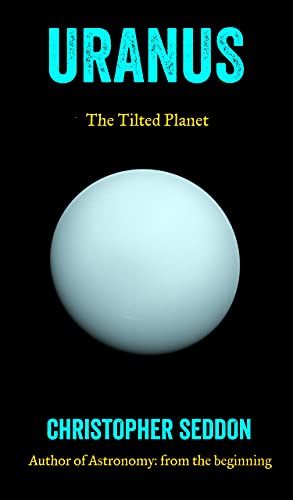Share This
Description
All you wanted to know about Uranus in a 12,000 work Kindle Short Read
Uranus is the first 'modern' planet, not having been discovered until 1781. Despite this, it is visible to the naked eye and possible sightings go back to the second century BC. But all these early observers thought that it was nothing more than a faint star.
Did you know?
*Uranus and Neptune were traditionally classed as gas giants along with Jupiter and Saturn, albeit the latter pair are much larger. In common with those of Jupiter and Saturn, the atmosphere of Uranus is primarily composed of hydrogen and helium, but it also contains ices including water, ammonia, methane, and traces of other hydrocarbons. Accordingly, many planetary scientists now refer to Uranus as an 'ice giant'.
*Illustrations in 1960s books on astronomy invariably depict Uranus and Neptune as identical grass-green worlds. As revealed by Voyager 2, Uranus is pale cyan, whereas Neptune is predominantly blue. The cyan colour results from the absorption of red light by methane in the atmosphere of Uranus.
*Uranus can be pronounced with the stress on the second syllable, which has made it the butt of schoolboy humour for decades. Consequently, astronomers invariably pronounce it with the stress on the first syllable. Either pronunciation is regarded as acceptable.
*Atmospheric temperatures of -224° Celsius on Uranus are lower than anywhere else in the Solar System.
Uranium, the 92nd element in the periodic table, and the heaviest occurring in nature, was discovered in 1789 in the mineral pitchblende. The discoverer, German chemist Martin Heinrich Klaproth (1743-1817) named the new element after Uranus, which had been discovered eight years previously.
Despite being more than fourteen times as massive as Earth, surface gravity is only 90 percent that of Earth. This means that if you could stand on the surface of Uranus, you would weigh only 90 percent of what you do on Earth.
Uranus is unique among the Solar System planets in having an axial tilt of just under 98°, meaning that the planet rotates on its side. This in turn means that Uranus experiences extreme seasons as the Sun moves from the vicinity of the north celestial pole to the south celestial pole and back over an 84-year cycle. For 21 years at a time, one pole will be in darkness and the other will be in daylight. Only around the equinoxes do most regions experience regular cycles of day and night.
Uranus has 27 known moons, far fewer than Jupiter or Saturn, albeit more than Neptune. Unlike Jupiter, Saturn, and Neptune (and, indeed, Earth), Uranus lacks a large moon. Its largest attendant, Titania, has a diameter of 1,578 kilometres (981 miles) or less than half that of the Moon. Only five moons were known before the Voyager 2 flyby in 1986. Ten new moons were discovered during the flyby, and an eleventh subsequently identified. The orbits of all these moons lie inside that of Miranda, innermost of the pre-Voyager 2 moons. Two more inner moons were discovered with the Hubble Space Telescope in 2003. The remaining nine moons all lie beyond the orbit of Oberon, outermost of the pre-Voyager 2 moons, and were discovered by ground-based observations between 1997 and 2003. The most recent discovery was Margaret in August 2003.
To date, Uranus has been visited by just one space probe, Voyager 2 in 1986. There are various proposals for further missions to Uranus, although none is likely to reach the planet before the mid-2040s.
Since its discovery in 1781, Uranus has completed only two circuits of the Sun. The third will not be completed until 2033.
Tag This Book
This Book Has Been Tagged
Our Recommendation
Notify Me When The Price...
Log In to track this book on eReaderIQ.
Track These Authors
Log In to track Christopher Seddon on eReaderIQ.

